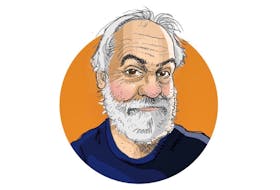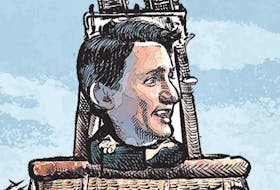I drove my metal box into a much bigger metal box, then drove down deeper into still yet another smaller metal box, then rode in a metal box up to the windowless metal box where I’d be spending the night.
Claustrophobic yet? I know I was.

Here’s that experience set out in a different way; I got on the Marine Atlantic ferry Highlanders, headed straight to my cabin, and got ready to sleep my way across the Gulf of St. Lawrence.
I thought about those two different ways of thinking as I thought about a Twitter post by a former colleague of mine, Geoff Meeker. He was talking about how, when people talk about the media being negative, they’re missing the point. First, Meeker suggested that reporters and others in the media care less about “negative” and “positive” than they do about whether something is accurate or not. And that’s definitely true.
But then he put forward something else: that an essential part of all news coverage is conflict. What makes a story readable or memorable is the interplay between the characters involved. The stronger the conflict, the better the story.
He argues that, if you hunt for it, all news stories contain conflict, even if the story is as simple as a sports star trying to regain their old form.
It’s true to a degree: I remember the great frustration I had during the five years I worked in television news, especially when the mere minute and a half of time a story might get (a story length sometimes referred to as “a buck-and-a-half”) left no time whatsoever for grey areas or nuance. It was simply good-guy-bad-guy-wrapup, a distilled reduction of conflict to fit the time slot, regardless of any ancillary important facts or details.
And then, the more I thought about that, the more I thought I might be in the wrong profession entirely.
One of the problems is that I’m wildly conflict-averse. A good yelling argument near me makes me want to find a closet to hide in. The other is that, after years in the news business, stories built solely on conflict bore me. It’s a bit like insisting that all communication be done in rhyming couplets.
Even reality shows have realized that conflicts carry a show only so far — eventually, it takes more to tell a story than just locking four stray cats in the same cardboard box and watching the inevitable unfold.
I don’t have a problem with rhyme.
I just don’t like it all the time.
But back to news stories and metal boxes: I do believe that the ease with which we can build news stories around conflict has built the mess we’re in now: our amped-up world of conflict upon conflict literally created Donald Trump, and sustains his administration through a host of misbehaviour that would not have been tolerated with earlier presidents. The next conflict is always bigger and more outrageous, meaning yesterday’s is forgotten, even if the lying is obvious. Politicians in Canada are aware of that, and are using it to their own benefit — playing groups off one another to build stories that they play dominant roles in, building profile.
I think there has to be more, though.
Even reality shows have realized that conflicts carry a show only so far — eventually, it takes more to tell a story than just locking four stray cats in the same cardboard box and watching the inevitable unfold.
So, just like good fiction, while news is often better with some inherent conflict and tension, conflict isn’t enough.
It also depends on people who can tell a story — and often, that takes a different set of eyes and ears. Or at least eyes and ears seeing things in a different way, just long enough to make you think about how they’re making a point.
Metal boxes, folks, metal boxes.
Russell Wangersky’s column appears in 36 SaltWire newspapers and websites in Atlantic Canada. He can be reached at russell.wangersky@thetelegram.com — Twitter: @wangersky.
MORE FROM RUSSELL WANGERSKY









